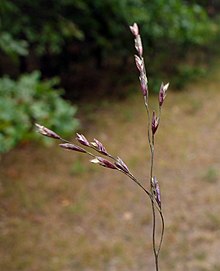
Back قبأ Arabic قبا (جنس من النباتات) ARZ Poa AST Qırtıc AZ Метлюжок BE Poa BS Poa Catalan Poa CEB Lipnice (rod rostlin) Czech Çӳçен CV
| Poa | |
|---|---|

| |
| Poa annua (annual meadow-grass) | |
| Scientific classification | |
| Kingdom: | Plantae |
| Clade: | Tracheophytes |
| Clade: | Angiosperms |
| Clade: | Monocots |
| Clade: | Commelinids |
| Order: | Poales |
| Family: | Poaceae |
| Subfamily: | Pooideae |
| Supertribe: | Poodae |
| Tribe: | Poeae |
| Subtribe: | Poinae Dumort. |
| Genus: | Poa L. (1753) |
| Synonyms[1] | |
|
Synonymy
| |


Poa[2] is a genus of about 570 species of grasses, native to the temperate regions of both hemispheres. Common names include meadow-grass (mainly in Europe and Asia), bluegrass (mainly in North America), tussock (some New Zealand species), and speargrass. Poa (πόα) is Greek for 'fodder'. Poa are members of the subfamily Pooideae of the family Poaceae.[3][4][5][6][7]
Bluegrass, which has green leaves, derives its name from the seed heads, which are blue when the plant is allowed to grow to its natural height of two to three feet (0.6 to 0.9 meters).[8][9][10]
The genus Poa includes both annual and perennial species. Most are monoecious, but a few are dioecious (separate male and female plants). The leaves are narrow, folded or flat, sometimes bristled, and with the basal sheath flattened or sometimes thickened, with a blunt or hooded apex and membranaceous ligule.[11][12][13]
- ^ Poa L. Plants of the World Online. Retrieved 2 July 2023.
- ^ From Greek πόα "grass, meadow."
- ^ Flora of China Vol. 22 Page 257 早熟禾属 zao shu he shu Poa Linnaeus, Sp. Pl. 1: 67. 1753
- ^ Flora of Pakistan
- ^ Altervista Flora Italiana, genera Poa Archived 2015-02-01 at the Wayback Machine includes photos and distribution maps for several species
- ^ Soreng, R. J. & P. M. Peterson. 2012. Revision of Poa L. (Poaceae, Pooideae, Poeae, Poinae) in Mexico: new records, re-evaluation of P. ruprechtii, and two new species, P. palmeri and P. wendtii. PhytoKeys 15: 1–104
- ^ "Poa L." Plants of the World Online. Board of Trustees of the Royal Botanic Gardens, Kew. 2022. Retrieved 23 January 2022.
- ^ What Makes Kentucky's Bluegrass Blue. New York Times. June 3, 1993.]
- ^ Longhi-Wagner, H. M. 1987. Gramineae. Tribo Poeae, in Fl. Ilust. Rio Grande do Sul. Boletim do Instituto de Biociências, Universidade Federal do Rio Grande do Sul 41: 1–191
- ^ Zon, A. P. M. v. 1992. Graminées du Cameroun. Wageningen Agricultural University Papers 92–1(2): 1–557
- ^ Cabi, E. & M. Doğan. 2012. Poaceae. 690–756. In A. Güner, S. Aslan, T. Ekim, M. Vural & M. T. Babaç (eds.) Türkiye Bitkileri Listesi. Nezahat Gökyiğit Botanik Bahçesi ve Flora Araştırmaları Derneği Yayını, Istanbul
- ^ Gibbs Russell, L. W., M. Koekermoer, L. Smook, N. P. Barker, H. M. Anderson & M. J. Dallwitz. 1990. Grasses of Southern Africa. Memoirs of the Botanical Survey of South Africa 58: i–ix,.
- ^ Negritto, M. A. & A. M. Antón. 2000. Revisión de las especies de Poa (Poaceae) del noroeste argentino. Kurtziana 28(1): 95–136